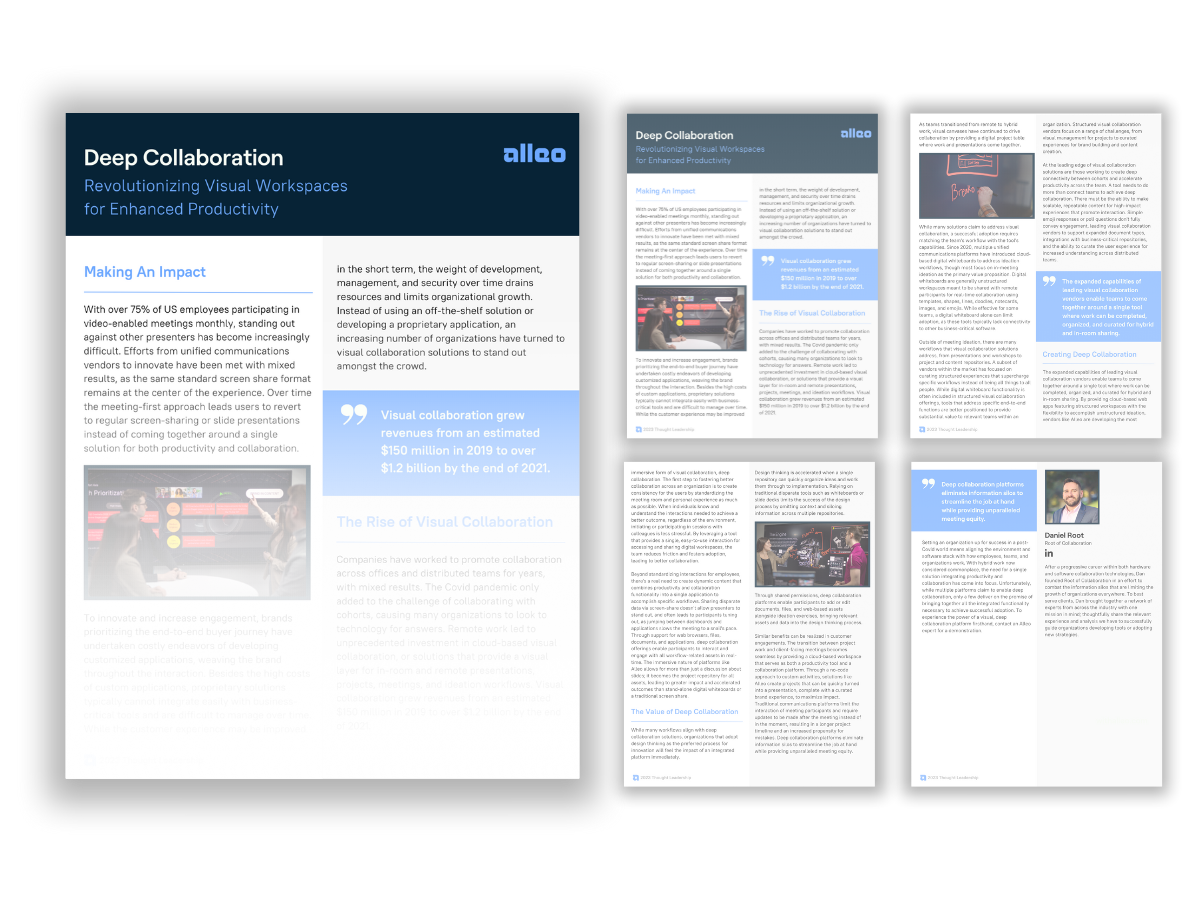Industry Resources
Get to Know Us
Alleo is revolutionizing how teams create personalized and immersive environments that drive collaboration and innovation in our hybrid world. Let’s talk so you can learn about Alleo and the people behind it.
Deep Collaboration Feature

Get your free copy:
Deep Collaboration Software for Business
It’s difficult to imagine a modern company that doesn’t highly value collaboration. Whether we’re talking about bringing together various teams or departments to roadmap, develop, and implement a new project or working closely with customers to help them achieve their objectives, effective collaboration supercharges such efforts.
The basic goal of collaboration is simple—bring people together to share viewpoints and perspectives so that innovative solutions can be brainstormed, developed, and implemented.
What are the hallmarks of effective customer collaboration—and what kinds of tools are needed? In this article, we’re going to explore the topic of collaboration from multiple angles, including:
- An overview of a few different types of collaboration, with a special emphasis on its importance within the workplace as well as the customer experience.
- The characteristics of effective collaboration, including the role of visual collaboration in streamlining collaborative processes and driving intended outcomes.
- The most important technology tools for collaboration and customer relationship building.
We’ve got a lot of ground to cover—let’s dive in!
What Does It Mean to Collaborate with Customers?
It should come as no surprise that customer experience is a major competitive differentiator for modern companies, since two-thirds of customers “expect companies to understand their unique needs” and to put them first.
This seems like a simple enough prospect, but companies aren’t always equipped to deliver. It’s also worth noting that customers prefer to work with companies that demonstrate genuine empathy in their words and actions—and while 68% of customers “expect brands to demonstrate empathy,” only 37% actually feel like companies do so. In the context of B2B relationship building, this is a big deal—and a great opportunity.
What Does Customer Collaboration Look Like?
Collaborating with customers might sound like a lofty aim, but in reality, it’s a vital element in understanding and empowering your customers. For the sake of simplicity, when we talk about collaborating with customers, we’re describing two different categories of activities: individual customer interactions and brand (or customer) experience centers.
- Individual customer interactions can include 1:1 meetings, strategy sessions, product demos, etc. Over the course of a customer’s relationship with your brand, these touchpoints provide opportunities to demonstrate empathy and meaningfully collaborate with customers. Each interaction presents a chance to show customers that they are understood and valued—and to help them thrive.
- Brand experience or customer experience centers are interactive spaces or events that provide an immersive experience for stakeholders and prospective/current customers. By fostering a collaborative spirit and authentically engaging with customers, companies can enhance their customer experience and demonstrate your company’s value as an ally or collaborator.
With each of these collaboration types, companies can demonstrate customer understanding and empathy by leveraging what Gartner calls a human-centric work design. Meaningful collaboration is the beating heart of human-centric work design, alongside flexible experiences and empathy-based management.
- Flexible experiences engage customers where (or how) they’re most comfortable. Customers shouldn’t have to jump through a bunch of hoops to feel like they’re being helped—it should be easy. Alleo’s flexible, visual-driven platform brings together everything you need to collaborate with customers and collects them within a single, accessible interface.
- Intentional collaboration refers to a company’s general approach toward collaboration, as well as the types of collaborative opportunities they provide. Collaboration shouldn’t be a one-off event—instead, companies should cultivate a collaborative environment in which working together is a normalized and consistent component of doing business. Alleo offers several features that can make collaboration less of a one-off occasion and more of a consistent element of the company’s approach to customer relationships. With a wide range of use cases and templates, companies can make customer collaboration easy!
- Empathy-based management simply means understanding—and meeting—customer needs. The more you know about what motivates customers, including the types of collaboration they’re most comfortable with or excited by, the better-positioned you’ll be to tailor the perfect, collaborative experiences. With Alleo, you can streamline processes and prioritize collaborative equity (making it easy for customers and companies to have equal access and opportunities to contribute to projects, in other words).
Taken together, these principles help companies to create a culture of customer collaboration—which keeps customers engaged and increases the likelihood of positive outcomes. Learn more about leveraging Alleos’ platform to help you forge better, more collaborative customer relationships through unique tools designed for customer presentations, workshops, training sessions, and more.
What Are the Different Levels of Collaboration?
In order from simplest to most complex, the levels of collaboration include:
- Networking, in which various stakeholders can share information and ideas. When customers and the business can access a single source of truth (i.e., the same information, perspectives, and guidelines to work with within), it’s much easier to meaningfully collaborate.
- Cooperation, in which customers and companies inspire and support each other’s initiatives. As customer relationships strengthen over time, specific roles and responsibilities can start being defined, laying the groundwork for more deliberate, potentially transformative collaboration.
- Coordination, in which company and customer roles are defined. and projects’ objectives, strategies, and timelines are created together. This is where a company can go from being a supportive resource for customers, to A more involved, in the trenches-type partner.
- Full collaboration, or deep collaboration, meaning an arrangement in which there is a firm commitment to collaboration. Deep collaboration is characterized by frequent conversations, a two-way exchange of ideas, and a shared commitment to the customer’s’ most-pressing objectives.
What Is Deep Collaboration?
Deep collaboration refers to a specific type of collaboration that involves creating a single, accessible destination (which may be in-person, remote, or hybrid) wherein companies and their customers can work together to solve problems and achieve objectives.
It might actually be easier to explain what deep collaboration isn’t. Let’s say QueenTech, a (fictional) software company, has decided to prioritize building better customer relationships. They begin to explore the possibilities, initially identifying a few different types of technology and collaborative tools that promise positive outcomes.
The problem is, even if each technology they select is, in itself, excellent and productive, the logistics of coordinating them—and helping customers understand their value and what their value is as well as how to use them—becomes tricky. Some customers are game, while others might feel like it’s just too much.
Deep collaboration software, by contrast, serves as a singular solution that brings together the features and capabilities of several tools in one. It’s worth noting that “deep collaboration” is a fairly new concept, so you’re not likely to find a market saturated with “deep collaboration software.” A term that’s getting more traction is “visual collaboration,” which we’ll pivot to next.
What Software Is Used for Collaboration?
For better or worse, countless tools are available that promise to improve companies’ ability to collaborate—internally and with their customers. Unsurprisingly, Gartner research indicates a sizable uptick in the number of collaboration tools being leveraged by businesses between 2019 and 2021, finding that “nearly 80% of workers are using collaboration tools for work.” In most cases, these companies are piecing together multiple tools; each of which is intended to serve a specific purpose.
What Are the Main Types of Collaboration Tools?
A few of the most common types of business collaboration tools include:
- Team Collaboration Software
More frequently used internally than with customers, team collaboration software includes features that help teams to communicate and share resources, which provides a solid foundation for collaboration. - Team Agility Software
Projects aren’t always going to go exactly as planned; priorities, objectives, desired outcomes, and timeframes can change. Team agility software helps business teams and customers adapt to keep projects moving forward in the face of unexpected hiccups. - Project Collaboration Software
Collaborative project management software provides a framework for delegating responsibilities, scheduling key tasks and milestones, coordinating and collaborating on deliverables, and so on. It can be used to keep customers in the loop or, even better, encourage and empower them to participate to whatever extent they’re comfortable with. - Network Collaboration Software
Network collaboration tools enable employees, teams, and customers to work together in real-time within an online, virtual environment—such as a visual collaboration platform like Alleo.
The More Tools the Better? Not Exactly…
Before you start shopping for different tools that align with each of the types of tools described above, consider how much more efficient and effective it would be to combine those functions. In the following sections, we’ll take a more detailed look at the different types of collaboration that occur within a business context and discuss a couple of key terms you should know:
- Deep collaboration, which is a varied and holistic approach to collaboration.
- Visual collaboration software, a type of collaboration software that simplifies collaboration by collecting essential information, resources, and tools within a single interface.
We may be getting ahead of ourselves, but only slightly. Before we get much deeper, let’s briefly define the different “levels” of collaboration within a business or customer relationship-building context.
What Is Visual Collaboration Software?
Visual collaboration software is a versatile and intuitive platform that creates engaging, informative experiences for customers and brands to connect and collaborate. Think back to the example we described above, the company with a handful of different tools for collaboration: one for communication, one for project management, and so on.
While our QueenTech example company provides the components of deep collaboration, they still rely on separate tools—which leads to inefficiencies. When that’s the case, companies and their customers can wind up in a familiar, repeating cycle of meeting, doing, and reviewing.
A meeting will be held, and then stakeholders will disband so they can work toward doing their part of the project plan. Once each stakeholder or team has done their part, they all come back together to review the progress and outcomes. If necessary, the cycle repeats. This is a familiar way of doing business, but it’s not ideal.
How Does Visual Collaboration Work?
A visual collaboration platform reinvents the meet, do, review process by bringing together the various purposes and processes that define deep collaboration, including communication, organization, time management, roadmapping, and more. And it brings them together within an intuitive, flexible interface.
You can think of it as a blank page you can use to assemble all kinds of different things—literally placing and interacting with them in a virtual layout. For example, you could include elements like:
- Charts, graphs, or infographics to visualize important data or other information.
- Instant messaging or video conferencing for real-time communication.
- Meeting agendas, notes, or milestones for keeping projects on track and moving forward.
- Interactive activities, such as whiteboarding.
Too often, each item requires participants to access a different resource, switch between internet tabs, or start up a different application. Bringing them together within a visual collaboration platform centralizes everything and makes it easy for everyone to stay engaged. Alleo makes it easy to develop your ideal visual collaboration experience by providing a number of configurable templates you can tailor to your needs.
Check out our Blog!

The Evolution and Intersections of Facilitation
The world has become increasingly connected through technological advances in the 2000s, revolutionizing how we learn and communicate.

Visual Collaboration Software
Let’s face it, a standard presentation won’t leave a lasting impression. Discover how to engage your customers with visual collaboration software here.

Hybrid Presentations and Workshops
In a world filled with in-person and remote workers, company events need to appease both groups. The solution? Hybrid meetings.
